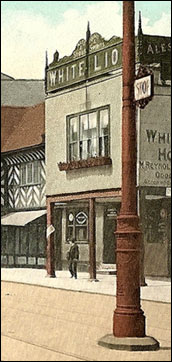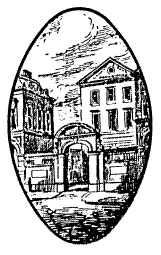 This detail from the 1875 Chester OS map features the corner of Foregate and Love Streets. This detail from the 1875 Chester OS map features the corner of Foregate and Love Streets.
The 1871 census lists The Golden Lion trading in Love Street. It was located just past the corner of Foregate Street on the left hand side, walking towards Grosvenor Park- a site now occupied by the old ABC Regal cinema recently vacated by Brannigan's.
At 79 Foregate Street was The White Lion Hotel. This inn may have been in existence before 1781, possibly under a different name, but it was first recorded as The White Lion when a brewer and churchwarden of St. John's, John Peers, took it on in that year.
The landlord in 1818-23 was George Truss, between 1840 and 1860 Samuel Lloyd. His inn is listed in the 1840 directory as follows: "White Lion Inn ( Heart of Oak Lodge of Independent Odd Fellows)". What was this? In 1873 George Smith was the licencee, and was still there in 1880. The landlady in 1898 was Mrs Mary Jane Nicolson. The licencee in 1902 was Thomas Reynolds, in 1910 Mrs Maria Reynolds and in 1914 Mrs Edward Partin. It was recorded as being used as a polling station in 1809.
 The right hand side of the map is dominated by the extensive grounds of Forest House. (actually, only the 'front garden' is shown- the grounds to the rear stretched much further down towards the river). Built in the 1780s as the town residence of the Barnston family of Crewe Hill, Forest House was the largest and grandest private house in Georgian Chester. The right hand side of the map is dominated by the extensive grounds of Forest House. (actually, only the 'front garden' is shown- the grounds to the rear stretched much further down towards the river). Built in the 1780s as the town residence of the Barnston family of Crewe Hill, Forest House was the largest and grandest private house in Georgian Chester.
After Sir Roger, the last of the Barnstons, died in 1837, the house became auction rooms and then served as a furniture depository, its wings were demolished- only the central block survives- and their site as well as the extensive gardens built upon. A branch of the Co-Op opened there around 1909 and the building housed a tea rooms/dancehall in the 1940s and 50s.
In the 1970s, it became a live music venue called Smarties (Smarty's?) where bands including The Cure, Adam and the Ants and The Pretenders performed. It eventually hosted a bewildering succession of night clubs including Angel's, High Society, Raphael's and, finally, Love Street until, in 2004 it was extensively- and very expensively- restored by Lee's Brewery, bringing back to view many remarkable architectural features which, during its nightclub phase had fortunately remained concealed and forgotten- but well protected- behind utilitarian panelling.
The result was The Mansion House- a complex of bars, restaurant and dance floors designed to appeal to a slightly older and more 'discerning' clientelle than were currently being catered for by Brannigan's just across the road and suchlike venues in the area. Sadly, the enterprise failed financially and The Mansion House closed within the year. In 2009, however, it reopened as part of the Wetherspoon's chain and continues to thrive as such today. Which is more than can be said of Brannigan's.
|


 The right hand side of the map is dominated by the extensive grounds of Forest House. (actually, only the 'front garden' is shown- the grounds to the rear stretched much further down towards the river). Built in the 1780s as the town residence of the Barnston family of Crewe Hill, Forest House was the largest and grandest private house in Georgian Chester.
The right hand side of the map is dominated by the extensive grounds of Forest House. (actually, only the 'front garden' is shown- the grounds to the rear stretched much further down towards the river). Built in the 1780s as the town residence of the Barnston family of Crewe Hill, Forest House was the largest and grandest private house in Georgian Chester.